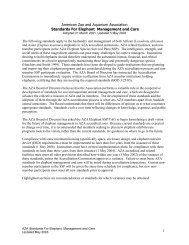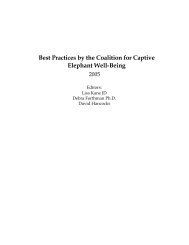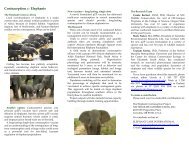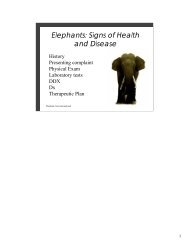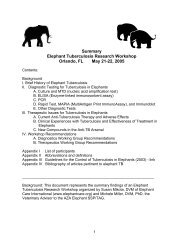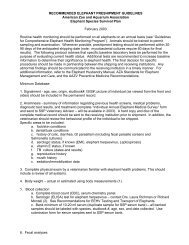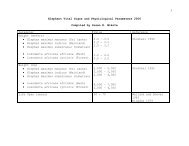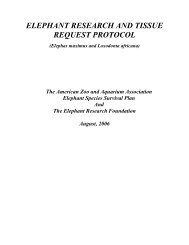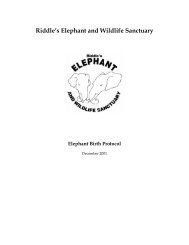Nepal Elephant TB Control and Mgt Action Plan.pdf - Elephant Care ...
Nepal Elephant TB Control and Mgt Action Plan.pdf - Elephant Care ...
Nepal Elephant TB Control and Mgt Action Plan.pdf - Elephant Care ...
- No tags were found...
Create successful ePaper yourself
Turn your PDF publications into a flip-book with our unique Google optimized e-Paper software.
<strong>Nepal</strong> <strong>Elephant</strong> Tuberculosis <strong>Control</strong> <strong>and</strong>Management <strong>Action</strong> <strong>Plan</strong> (2011-2015)Respiratory Sample Collecon ProceduresThe <strong>Nepal</strong> <strong>Elephant</strong> <strong>TB</strong> <strong>Control</strong> <strong>and</strong> ManagementAcon <strong>Plan</strong> has established collaboraons withthe <strong>Nepal</strong> An-tuberculosis Associaon, theCenter for Molecular Dynamics-<strong>Nepal</strong> (CMDN),<strong>and</strong> the experts in this field to improve methodsto idenfy <strong>TB</strong> bacterial shedding in elephants.The following procedures may change as newknowledge is gained.Loop-mediated isothermal amplificaon (LAMP)is a molecular technique that has been used todiagnose <strong>TB</strong> in humans in <strong>Nepal</strong> (P<strong>and</strong>ey 2008).It is accurate in humans <strong>and</strong> may prove to be aneffecve diagnosc tool for elephants but shouldbe performed in conjuncon with culture <strong>and</strong>PCR. Collect samples in the a ernoon a er theelephant has been acve <strong>and</strong> moving around.Collecon of trunk wash or liquid nasal dripsample for culture, PCR, <strong>and</strong> LAMP1. Wear an N95 mask <strong>and</strong> exam gloves.2. Pre-label a plasc 50 ml screw top centrifugetube with the elephant’s name, project ID#,facility locaon, <strong>and</strong> date of collecon. Thissample will be for culture.3. Pre-label a 4.5 buffer-filled nunc tube for DNAextracon, PCR, <strong>and</strong> LAMP.3. Collect st<strong>and</strong>ard trunk wash sample or 10ml of a nasal drip sample in a shallow largediameter plasc tub or a large jar.4. Transfer the sample into a plasc 50-mlscrew top centrifuge tube by pouring or use adisposable syringe or pipe!e. If the sample isgrossly contaminated, pour through a gauzesponge.5. Dip a clean sterile swab into the sample <strong>and</strong>place the swab in the buffer-filled nunc tube.6. Refrigerate samples unl they can be shipped.7. If plasc pipe!es or syringes have been used,place them in a jar containing bleach. Allowto remain for ~ 10 minutes then dispose intored biohazard container.8. Send samples by courier to CMDN. CMDNwill forward culture samples to NATA <strong>and</strong>DNA-extracted samples to Dr. P<strong>and</strong>ey’slab. Samples should reach NATA as soonas possible as prolonged storage me canadversely affect results.Collecon of oropharyngeal swab for culture1. Wear N-95 mask <strong>and</strong> exam gloves.2. Place a culture!e on the end of the aluminumrod designed for this purpose3. Swab the oro-pharyngeal region.4. Place the swab in the tube <strong>and</strong> compress theend to release the transport media.5. Label with the elephant’s name, project ID #,collecon date, <strong>and</strong> facility abbreviaon.6. Refrigerate; ship to CMDN as soon as possible.CMDN will forward to NATA.Collecon of oropharyngeal swab for PCR <strong>and</strong>LAMP1. Wear N-95 mask <strong>and</strong> exam gloves.2. Place a sterile co!on swab on the end of aplasc extension rod.3. Swab the oro-pharyngeal region.4. Place the swab in the pre-labeled, buffer-fillednunc tube.5. Label with the elephant’s name, project ID #,facility abbreviaon, <strong>and</strong> collecon date.6. Refrigerate; ship to CMDN as soon as possible.9




